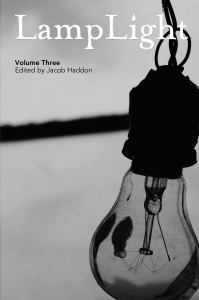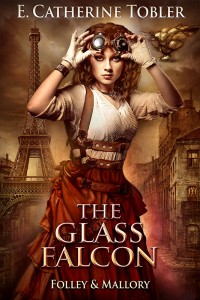Read The Glass Falcon, which continues the adventures of Folley and Mallory, out now!
* * *
E. Catherine Tobler, author of Rings of Anubis, and all around extraordinaire. Her work has appeared in LampLight, a story called “By The Book” which was a literary sci-fi detective story. She helps edit over at Shimmer, and current has a story at LightSpeed.
Her new book, Rings of Anubis came out in July, so we talked with her about it, writing and what is coming up.
* * *
APOK: Rings of Anubis has just been released, tell us about it
ECT: First and foremost everyone should know it’s the best book ev–
Er, Rings of Anubis is my first novel, and I’m equal parts excited and nervous over it. It’s very strange to have people buying your book and reading the words you’ve worked on for so long. You wonder how they will react and then realize you have to let go of that, because that’s out of your control.
Rings of Anubis is a mashup of science fiction, fantasy, steampunk, and historical fiction, taking our heroine from turn of the century Paris to Cairo where she will undercover secrets–though they aren’t the secrets she thinks they are. Along the way, she encounters werewolves, ancient Egyptian gods, and a side of herself she never knew. As you do.
APOK: Writing historical fantasy, I assume, presents its own sets of troubles, with both history and your world building creating their own rules. Did you have troubles with that? Did you find yourself having to bend one rule set to make it fit with the other?
ECT: There is certainly an aspect of the book that is alternate history. When the story began to take on a fuller shape, I knew there was no way it would be Exactly What Happened In History. It was also important to me to respect the actual history of Egypt, mindful of the customs and myths as I worked to build my own alternate version. Wanting to both show and respect the magic of Egypt was a fine line to walk.
I kept having to tweak what I’d already done to make sure everything stayed where I’d put it–kind of like when you’re making a model, or a puzzle, and the pieces don’t totally snap together, so you realize you’ve borked something earlier in the process. Branching off from real historical events was hard to wrap my mind around at times. “It didn’t happen like that,” I would find myself thinking, and being okay with that was a slow process.
APOK: Were you drawn to this time period first? or had you been working on a story and thought “you know, if i set this in Paris… yes yes…(maniacal laughter, mad scientist noises)” ?
ECT: I was not drawn to this time period first. The book started set in the near future; picture Blade Runner but not quite so rainy and bleak. I knew I wanted to talk about the preservation of the past by someone who had a personal stake in that preservation, but when coupled with the technology of the future replacing it, the set up felt entirely too much like Tolkien and his nature vs. technology arguments in LotR. So I took a step backward and started to wonder.
It was while I was looking at images of the Eiffel Tower under construction that it hit me. What could possibly be more metal and steampunk than the Eiffel Tower? I knew at that point it was Paris in addition to Egypt, I just needed to determine Paris of what era. World’s Fairs have always fascinated me and when I read more about the Tower, and why and when it was built, everything fell together naturally from that point. Seeing airships actually photographed around the Eiffel Tower…
Well yes, there was maniacal laughter at that point.
APOK: Tell me a little bit about how you became a writer to begin with
ECT: I started writing fan fiction, chiefly Star Trek, because stories where people are on journeys, seeing strange worlds and new ideas remain intoxicating for me. Fan fiction gave me a safe place to practice, and introduced me to a bunch of friends who also wrote. Then, Pocket Books did its Strange New Worlds anthologies, which is where I made my first pro sale (I was in SNW #4 and #5). But when Trek-writing friends began to write Trek novels, I realized I wanted to write in my OWN worlds, so took that leap and never looked back.
APOK: Do you have a specific writing process? Mood lighting and light music, or a crazy hectic coffee shop?
ECT: I sit down. I apply my fingers to the keys. I type.
Okay–possibly it’s not that basic (but it also is). I have a brain that doesn’t want to write every day and when I stopped trying to force that, I became a happier and more productive writer, and I also started to sell more.
I’m the kind of writer who fills up on art, music, movies, the creative output of others, and feeds all of that into the “writing” part of my brain, before spewing words onto the page. And after I’ve emptied all those ideas, I have to go back and fill up again.
Some stories get soundtracks; some don’t. Sometimes I write in complete silence. Mostly, the writing happens at my desk, no coffee shops, no libraries, because when I’m out, I watch people–I find myself filling back up, rather than writing.
APOK: What is on the horizon? Releases? Appearances? Dance off-s?
ECT: I am appearing daily at my desk for editing and writing adventures! I may also attend MileHiCon in Denver later this fall. (http://www.milehicon.org/)
“A Box, a Pocket, a Spaceman” appears in the August Lightspeed (and will be free on the site starting August 19).
As for releases, September sees another book from me (in digital release to start), Watermark. This is the story of a fairy who is sent to the human world as a kind of punishment; of course things don’t always go as planned, and the center cannot hold. Chaos ensues!
As to dance offs, we totally have a future date with one of those. Maybe we’ll cosplay as Daft Punk at the 2015 Worldcon?
Check out Rings of Anubis, out now in print and ebook, as well as some more links below.
 zine, collected into a single volume, featuring issues from September 2014 – June 2015
zine, collected into a single volume, featuring issues from September 2014 – June 2015 A bungled museum theft. An ancient Egyptian riddle.
A bungled museum theft. An ancient Egyptian riddle.
